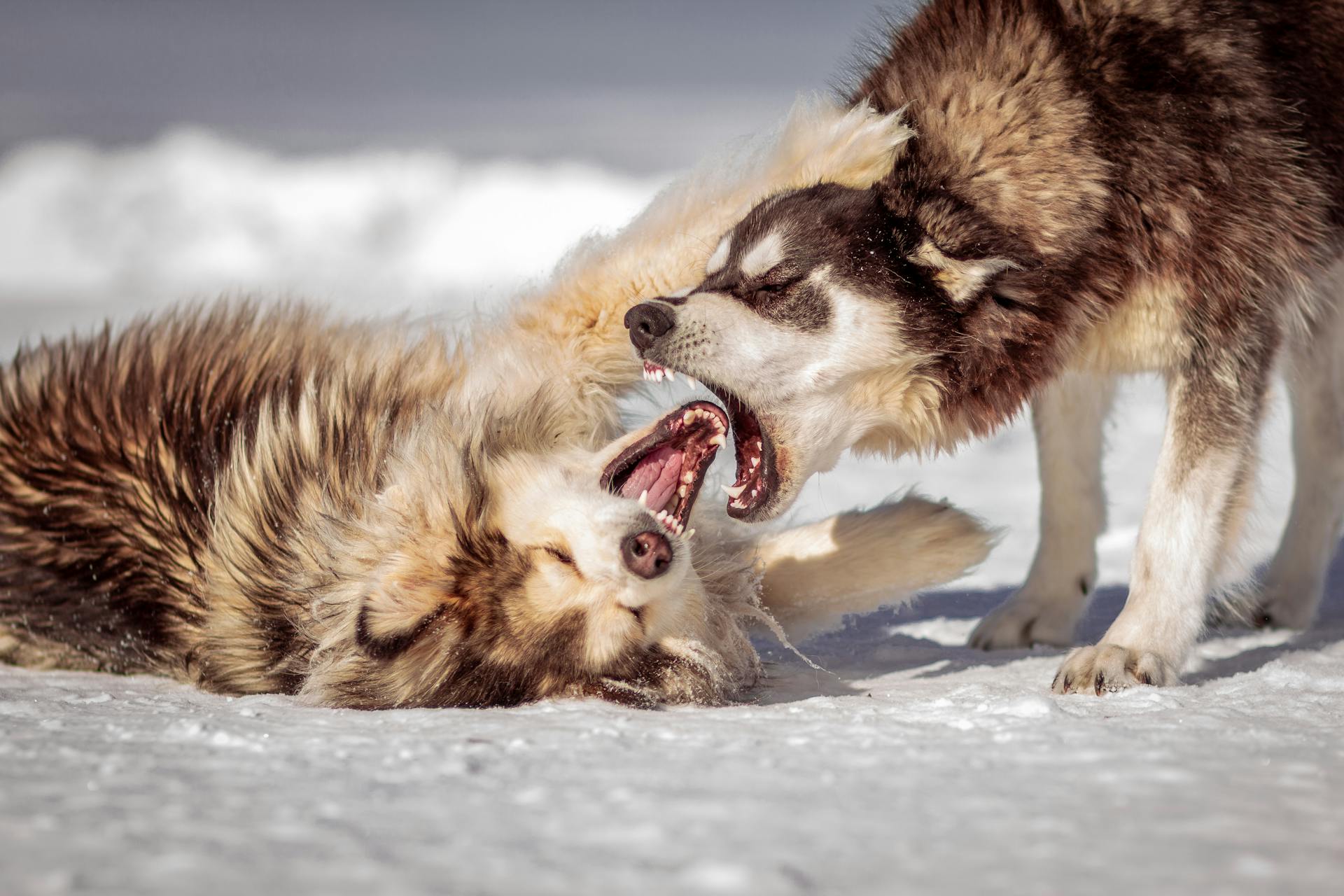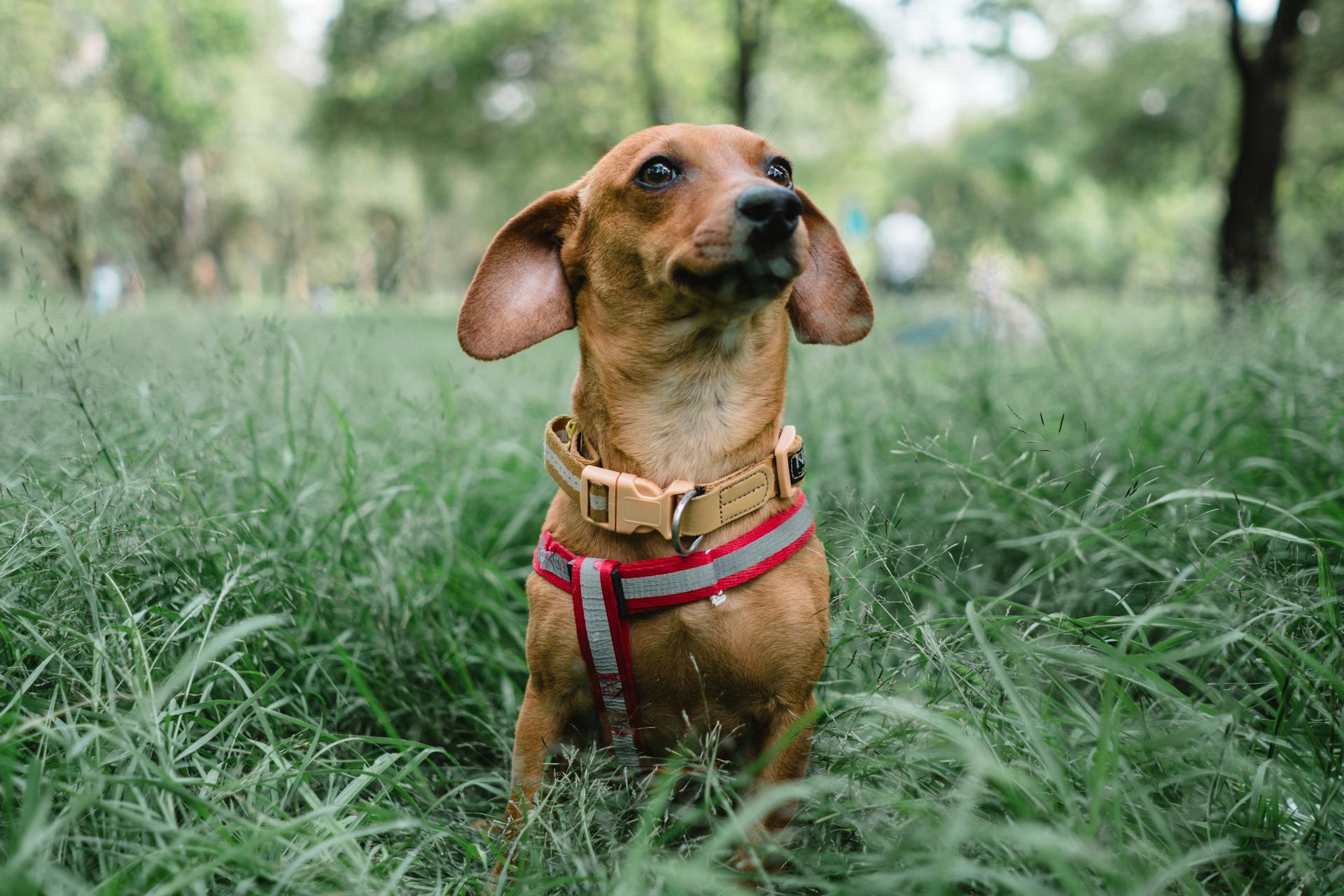
Sudden aggression in dogs can be a scary and confusing experience for both pet owners and their furry friends. A sudden change in behavior can be a sign of underlying medical issues such as pain, discomfort, or neurological problems.
Common triggers for sudden aggression include loud noises, strangers, or other animals. These triggers can cause even the calmest dog to become aggressive.
If you notice any of these signs, it's essential to remain calm and assess the situation. This will help prevent further escalation and ensure the safety of both you and your dog.
Some dogs may exhibit aggression due to fear or anxiety, which can be caused by changes in their environment or routine.
Worth a look: Dog Losing Hearing
Causes of Aggression
Hormonal changes during a female dog's heat cycle can lead to increased levels of anxiety and aggression. This is a common cause of sudden aggression in dogs.
A female dog in heat may become more aggressive in order to protect herself from unwanted advances from male dogs. This protective instinct can be intense and may result in biting or snapping.
Pain is another medical cause of canine aggression. A female dog in heat may also become more aggressive if she is in pain due to the heat cycle itself or due to an underlying medical condition.
Here are some common medical conditions that may contribute to or cause canine aggression:
- Hormonal changes during a female dog's heat cycle
- Pain due to the heat cycle or underlying medical condition
- Protection of herself or her pups from unwanted advances
Causes of Leash
Leash aggression is a common issue many dog owners face, and it's essential to understand the underlying causes to address it effectively.
Greeting on leash is unnatural for dogs, forcing them to approach head-on and making hard eye contact, which can lead to barking, lunging, and growling.
Dogs feel trapped on a leash, unable to increase the distance between each other, leading to an explosion of barking and stress.
Improper greeting techniques, such as letting your dog charge up to another dog, can be perceived as rude behavior among dogs, resulting in disciplinary actions like barks and growls.
Improper correction methods, like forcing your dog to sit or lie down in the approaching dog's path, can increase anxiety levels and make your dog more aggressive.
If a puppy never experiences corrections for inappropriate greetings, he may carry this behavior into adulthood, leading to aggression towards other dogs.
Dogs on tight leashes can become more stressed, leading to an increase in barking and growling.
The following list summarizes the causes of leash aggression:
- Greeting on leash is unnatural for dogs.
- Dogs feel trapped on a leash.
- Improper greeting techniques can be perceived as rude behavior among dogs.
- Improper correction methods can increase anxiety levels and make your dog more aggressive.
At What Age Do Males Become Aggressive?
Male dogs can become aggressive at any age, but it's most common during puberty (around 6-9 months old) and prime years (2-5 years old).
Hormonal changes during puberty can contribute to aggression toward other male dogs. This is a normal part of development, but it's essential to address any aggressive behavior early on.
Sudden changes in routine or environment can also trigger aggression in male dogs. For example, introducing a new dog or baby to the household can be a significant stressor.
You might like: 6 Month Old Puppy Resource Guarding
Fear is another common trigger for aggression in male dogs. If a male dog is afraid of another dog, person, or object, he may become aggressive in an attempt to protect himself. This is why socialization is crucial from an early age.
Pain or illness can also cause aggression in male dogs. If a male dog is in pain, he may become aggressive as a way to protect himself or get attention.
Male dogs that are not properly socialized may be more likely to become aggressive towards other dogs. Socialization helps dogs learn to interact with other house pets or wild animals and people in a positive way.
For your interest: Dog Training for Socialization
Why Do Show?
Dogs show aggression for one or more of the following reasons: they may be feeling threatened, scared, or territorial.
Most often, your dog will display aggression due to a perceived threat or a fear response. Knowing why your dog is acting aggressively can help you make the best plan for stopping this frightening behavior.
Some common triggers for aggression include resource guarding, such as food or toys, and protective instincts around family members or their belongings.
Dogs may also show aggression due to a lack of socialization or training, leading to fear and anxiety responses.
Expand your knowledge: Dog Fear Aggression
Female Aggression
Female aggression is a common concern for many dog owners. Some female dogs may become more aggressive during their heat cycle due to hormonal changes.
A female dog in heat may become more aggressive in order to protect herself from unwanted advances from male dogs. This is a natural instinct to safeguard her reproductive health.
Pain can also contribute to aggression in female dogs. If a female dog is in pain due to the heat cycle itself or an underlying medical condition, she may become more aggressive.
Barking, growling, lunging, snapping, and skin biting are all signs of aggression in female dogs. If you notice any of these behaviors, it's essential to consult with a veterinarian or animal behaviorist.
To prevent aggression in female dogs, it's crucial to keep them away from male dogs. This simple step can reduce the likelihood of your female dog feeling threatened or anxious.
Discover more: How to Become a Trainer of Service Dogs
Medical Causes
Medical causes of sudden aggression in dogs can be just as puzzling as behavioral causes. Hormonal changes during a female dog's heat cycle can lead to increased levels of anxiety and aggression.
Pain is a common medical cause of aggression in dogs. A female dog in heat may become more aggressive if she is in pain due to the heat cycle itself or due to an underlying medical condition. Pain can also cause aggression in male dogs if they have an injury or illness.
Some medical conditions can cause dogs to become aggressive. These include congenital or acquired neurological problems such as hydrocephalus, encephalitis, head trauma, brain tumors, and epilepsy.
Here are some specific medical conditions that can cause aggression in dogs:
Hormonal Changes
Hormonal changes play a significant role in canine aggression, particularly in female dogs.
Hormonal fluctuations during heat cycles can lead to increased anxiety and aggression. This is a common phenomenon, and many dog owners have witnessed their female dogs become more irritable during this time.
Pregnancy and postpartum periods are also marked by significant hormonal changes, which can contribute to aggression in female dogs. It's essential to be aware of these changes and take necessary precautions to ensure the dog's safety and the safety of those around her.
Suggestion: Crate Training during the Day

Female dogs in heat may become more aggressive to protect themselves from unwanted advances from male dogs. This protective instinct can be intense, and owners should take steps to prevent unwanted breeding.
Some common signs of hormonal-related aggression in female dogs include restlessness, anxiety, and irritability. If you notice these behaviors in your dog, it's crucial to consult with a veterinarian to rule out any underlying medical conditions.
Neurological Problems
Neurological problems can be a complex and challenging issue to tackle when it comes to canine aggression. Some medical conditions can affect a dog's brain, leading to aggression that seems unreasonable.
Pain and discomfort can be a major contributor to aggression in dogs. If your dog is in pain, it may become aggressive as a way to protect itself or get attention.
Conditions such as cognitive dysfunction, brain tumors, and other brain diseases can affect a dog's perception and judgment, causing inappropriate behavior. These problems are more likely to occur in older dogs but can happen at any age.
Hydrocephalus, a condition where fluid accumulates in the brain, can cause aggression in dogs. It's most common in short-nosed breeds, also known as brachycephalics.
Encephalitis, which is inflammation of the brain, can also cause aggression in dogs. This can be caused by either a bacterial or viral infection.
Head trauma can cause regional swelling and bleeding in the brain, leading to aggression in dogs.
Epilepsy can cause aggression in dogs, particularly in the immediate post-seizure phase. Dogs with epilepsy may be more aggressive before they fully recover from a seizure.
Here are some neurological problems that can lead to aggressiveness in dogs:
- Hydrocephalus – most common in short-nosed breeds (brachycephalics)
- Encephalitis (bacterial or viral)
- Head trauma
- Brain tumors
- Epilepsy
Rage Syndrome
Rage Syndrome is a misunderstood condition that has been overdiagnosed in the past. True idiopathic aggression is extremely rare and difficult to treat.
A thorough investigation of a dog's behavior history and owner's observations can often reveal explainable causes for aggression, such as status-related aggression or resource guarding. These conditions can also generate violent and explosive reactions.
Some owners may miss their dog's warning signs prior to a status-related attack, especially if the warning signs have been suppressed by prior physical or verbal punishment. A dog's list of guardable resources can be limited and precise, but also difficult to identify and recognize.
Here's a list of some breeds that are known to be prone to seizure-related aggression, which can result in sudden and unprovoked aggression:
- Springer spaniels
- Cocker spaniels
- Chesapeake Bay retrievers
- Bull terriers
- Poodles
- Golden retrievers
These breeds may exhibit a range of symptoms, including a mood change before the seizure, sudden violent aggression, and signs of autonomic discharge.
Behavioral Seizures
Behavioral seizures can cause sudden, unprovoked aggression in dogs. This type of aggression is different from other forms of aggression and is often associated with breeds such as Springer spaniels, cocker spaniels, Chesapeake Bay retrievers, bull terriers, poodles, and golden retrievers.
A mood change can occur just before a seizure-related aggression episode. This can be a warning sign that something is about to happen.
Sudden violent aggression can occur for trivial or no reason at all. This is a hallmark of seizure-related aggression.
Signs of autonomic discharge, such as salivation, dilated pupils, and evacuation of anal sacs, can also be present during a seizure-related aggression episode.
Aggressive posturing can be continuous during an attack, lasting several minutes, hours, or even days. This can be a frightening experience for both the dog and its owner.
Following a bout of aggression, affected dogs often appear depressed and lethargic, unresponsive to commands, and may stare at a wall or simply sleep. This can be a difficult time for owners to navigate.
An electroencephalogram (EEG) will often demonstrate abnormalities in dogs with seizure-related aggression. This can help confirm the diagnosis.
Some dogs with this type of aggression may respond to treatment with anti-convulsants, such as phenobarbital.
Earmarks of Idiopathic
Idiopathic aggression is a rare condition, but if you're concerned that your dog may be experiencing it, there are some earmarks to look out for. The onset of idiopathic aggression is most commonly reported in dogs between 1-3 years old.
Some owners report that their dogs get a glazed, or "possessed" look in their eyes just prior to an idiopathic outburst, or act confused. This can be a warning sign that an episode is about to occur.
Certain breeds seem more prone to suffer from idiopathic aggression, including Cocker and Springer Spaniels, Bernese Mountain Dogs, St. Bernards, Doberman Pinschers, German Shepherds, and Lhasa Apsos. This suggests a possible genetic component to the problem.
In some cases, dogs may foam at the mouth and twitch during an episode, which could be an indication of epileptic seizures. This can make it even harder to diagnose idiopathic aggression.
Rage Syndrome Treatment
Idiopathic aggression, also known as "rage syndrome", is a rare condition that's often misdiagnosed. Unfortunately, the condition is extremely rare, and the label gets applied too often by uneducated dog folk.
The prognosis for idiopathic aggression is very poor, and many dogs must be euthanized due to the unpredictability of their outbursts. This is why it's essential to work with a skilled and positive trainer/behavior consultant to rule out more explainable causes of aggression.
A good behavior modification program, applied by a committed owner in consultation with a capable behavior professional, can succeed in decreasing and/or resolving many aggression cases. This approach can help you devise appropriate management plans to keep family members, friends, and visitors safe.
If your behavior professional believes you have a rare case of idiopathic aggression, a trip to a veterinary behaviorist is in order. Some dogs may respond to drug therapies for this condition, but many will not.
Phenobarbital has been reported to have some minor success in reducing aggression, but it's unclear whether the results are due to the sedative effect of the drug or an actual therapeutic effect.
Managing Aggression
Managing aggression in dogs requires a thoughtful and calm approach.
Staying calm and confident is crucial when dealing with an aggressive dog, as dogs can sense fear and anxiety.
Speak to your dog in a calm voice to help calm them down and let them know you're not a threat.
Don't yell at or punish your dog, as this will only make the problem worse.
Instead, try to be patient and understanding, and set clear boundaries and expectations for your dog.
If your dog lurches or barks at other dogs on walks, it's essential to consider the leash-reactive behavior and find ways to manage it.
Distract your dog with something else, like a toy or a treat, if you can't remove the trigger.
Preventing Leash Issues
Forcing your dog to greet another dog on a leash can be unnatural and stressful for them. This can lead to barking, lunging, and growling as they try to prevent a potential fight.
Dogs feel trapped on a leash and can't increase the distance between each other, which can cause an explosion of barking as both dogs go from flight to fight. This can be misinterpreted as the dogs being fine because they're not barking or growling, but in reality, they're showing signs of stress like pacing, panting, and flattened ears.
For another approach, see: Doberman Pinscher Growling
Improper greetings, such as letting your dog charge up to another dog and jump on them, can be seen as rude behavior among dogs. This can be the result of insufficient dog-dog socialization past the young puppy stage.
To prevent leash issues, it's essential to recognize signs of stress in your dog, such as pacing, panting, and flattened ears. These signs can indicate that your dog is feeling trapped and anxious on a leash.
Here are some tips to help you prevent leash issues:
Correcting your dog for perceived aggression can actually increase their anxiety level and make them more aggressive in the long run. This can lead to punishment, yelling, or jerking the leash, which can cause your dog to redirect their aggression onto you.
Training and Behavior
If you're dealing with a dog that's suddenly become aggressive, it's essential to seek help from a professional. A certified professional dog trainer or veterinary behaviorist can assess your dog's behavior and develop a plan to address the problem.
You can also try teaching your dog alternate behaviors, such as basic obedience commands like "sit" or "lie down." This can help calm your dog and make you safer.
Consistency is key when training your dog. If you're consistent with your commands, your dog will be less likely to become aggressive. It may take time, but with patience and understanding, most dogs can learn to control their behavior.
Providing your dog with plenty of exercise can also help reduce stress and frustration, which can lead to aggression. A tired dog is a happy dog, and regular exercise can make a big difference.
For more insights, see: Does Cbd Help with Dog Aggression
Consistency in Training
Consistency is key when it comes to training your dog. If you are consistent with your commands, your dog will be less likely to become aggressive.
Dogs learn what is expected of them, and a consistent routine helps them understand what behavior is acceptable. This can be a major factor in preventing aggression.
It may take some time to work with your dog and address their aggressive behavior, but being patient and understanding is crucial. With patience and consistency, most dogs can be taught to control their aggressive behavior and become a loving companion.
Consistency in training can also help reduce stress and frustration, which can lead to aggression. A tired dog is a good dog, and exercise and trips to the dog park can help reduce stress and frustration.
Worth a look: Does Neutering Dog Help with Aggression
At What Age Do People Become Aggressive?
People can become aggressive at any age, but it's most common during significant life changes.
Puberty is a common time for people to experience mood swings and irritability, similar to female dogs around 6-9 months old.
Some people may also become aggressive during times of stress or uncertainty, much like female dogs during their heat cycles.
Pregnancy and new parenthood can be emotionally challenging, leading some individuals to become aggressive as they navigate these life-changing events.
It's essential to recognize that aggression can arise at any age, and it's not limited to specific life stages.
Broaden your view: Crate Training Schedule by Age
Possessiveness
Possessiveness is a common issue in dogs, often triggered by food, toys, or other valuable objects. A dog may growl if someone approaches his food bowl or gets too close while he's chewing a favorite toy.
Resource guarding can also lead to aggression towards other household pets, causing dogs to growl, snap, or bite at other animals who approach their food bowl, bed, or favorite toy.
Some dogs are more protective of their territory, barking violently at people just outside the property boundary or fence, or even biting strangers who step into their home. This is a common scenario with dogs who "hate the mail carrier".
The degree of aggression can vary greatly from one dog to another, and even between objects of value. For instance, a dog might not care if you sit down and pet him while he chews a rubber toy, but turn and snap at you when you do the same thing with a dental chew.
Explore further: Why Is My Female Dog Whining and Carrying a Toy
Frequently Asked Questions
What is sudden onset idiopathic aggression in dogs?
Sudden Onset Idiopathic Aggression in dogs is a rare condition characterized by sudden and unexplained episodes of aggression, often occurring in young males between 6 months to 2 years old. This condition shares similarities with schizophrenia in humans and requires prompt attention from a veterinarian to determine the best course of treatment.
Sources
- https://www.bulldogology.net/why-is-my-dog-being-aggressive-all-of-a-sudden/
- https://www.petplace.com/article/dogs/pet-behavior-training/medical-causes-of-aggression-in-dogs
- https://www.whole-dog-journal.com/behavior/rage-syndrome-in-dogs/
- https://www.animalhumanesociety.org/resource/aggression-dogs
- https://www.thesprucepets.com/top-causes-of-aggression-in-dogs-1117877
Featured Images: pexels.com


